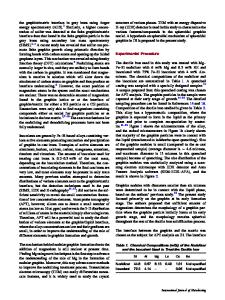3D Quantitative Analysis of Graphite Morphology in Ductile Cast Iron by X-ray Microtomography
- PDF / 6,837,248 Bytes
- 10 Pages / 593.972 x 792 pts Page_size
- 15 Downloads / 269 Views
I.
INTRODUCTION
DUCTILE cast iron (DCI) is an important kind of metal material that has high strength, good toughness, low cost, and impeccable castability. DCI was first introduced to manufacturing in the 1940s,[1] and it has been researched and used for more than 70 years. DCI has been widely used because of its comprehensive mechanical property and processability.[2] The mechanical properties of DCI are seriously influenced by the morphology of the graphite nodule, including count, diameter, sphericity, and spatial distribution. For instance, the sphericity, and spatial distribution of nodules affect strength and toughness. Fatigue strength is influenced by count and diameter.[3–5] Numerous studies using a variety of methods have been conducted to investigate the graphite morphology of DCI, and of all the methods, thermal analysis is an available and effective way. Chen et al.[6] predicted sphericity of nodules in hypoeutectic DCI correctly by computer-aided differential thermal analysis. Zhu et al.[7] found that the thermal analysis results were not only microstructure (graphite morphology) sensitive but also nodulizer and trace element sensitive. YAJUN YIN, ZHIXIN TU, JIANXIN ZHOU, DONGQIAO ZHANG, MIN WANG, ZHAO GUO, CHANGCHANG LIU, and XIANG CHEN are with the State Key Laboratory of Materials Processing and Die & Mould Technology, Huazhong University of Science and Technology, Wuhan 430074, Hubei Province, P.R. China. Contact e-mail: [email protected] Manuscript submitted December 21, 2016. Article published online May 23, 2017 3794—VOLUME 48A, AUGUST 2017
Sheikhabdolhossein[8] investigated the spheroidization fading phenomenon by analyzing the cooling curves of DCI with the addition of a nodulizer under different lengths of heat preservation time. They found that the magnitude of undercooling increased and that the temperature of eutectic undercooling decreased because of the processing of fading. Some quantitative models were also established.[9–12] For example, Kapturkiewicz et al.[10] established a solidification mathematical model for near-eutectic, thin-wall DCI castings, and the correctness of the mathematical model was experimentally verified by comparison with characteristic points on the cooling curve and nodule count. Liquid quenching and metallography analysis, as basic approaches, still play important roles. Natxiondo et al.[13] researched graphite and solid fraction evolutions during solidification of DCI by liquid quenching. The metallography can present two-dimensional (2D) morphology of graphite directly comparing with thermal analysis. Image analysis was used to evaluate nodule count, graphite diameter, and sphericity, matrix structure by Ruxanda and Stefanescu.[14] Morales-Herna´ndez et al.[15] studied 2D spatial distribution and sphericity characterization of graphite nodule based on morphological tools. As research continues, study of three-dimensional (3D) morphology such as size and count appears and becomes more relevant. Basak[16] first put forward a method to characterize the 3D size dis
Data Loading...











